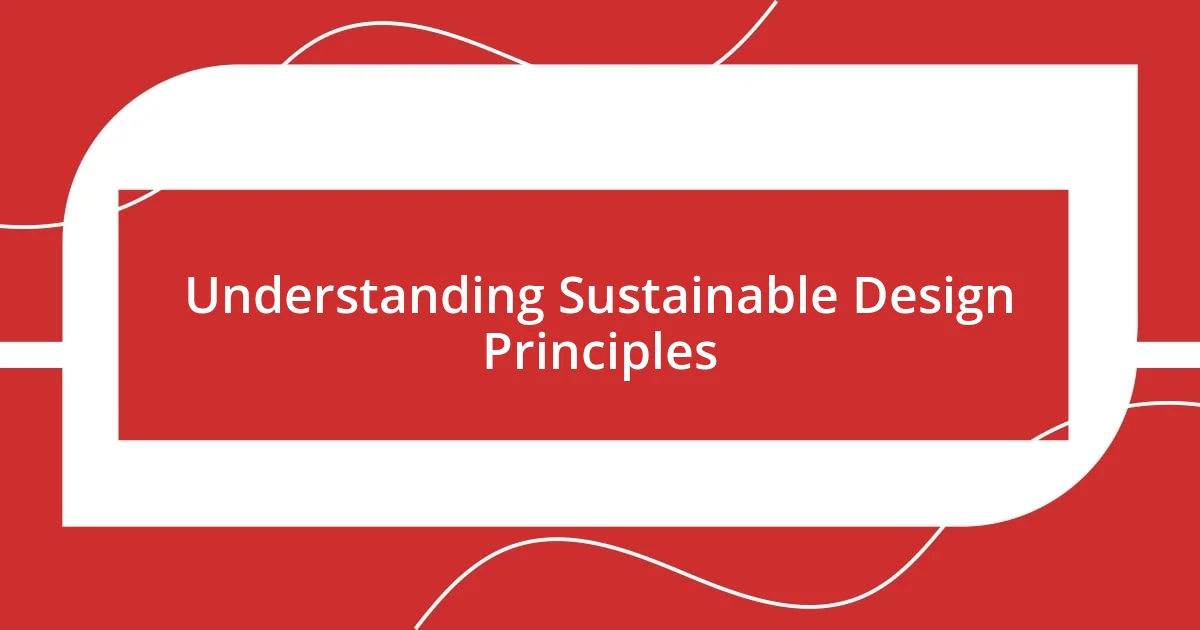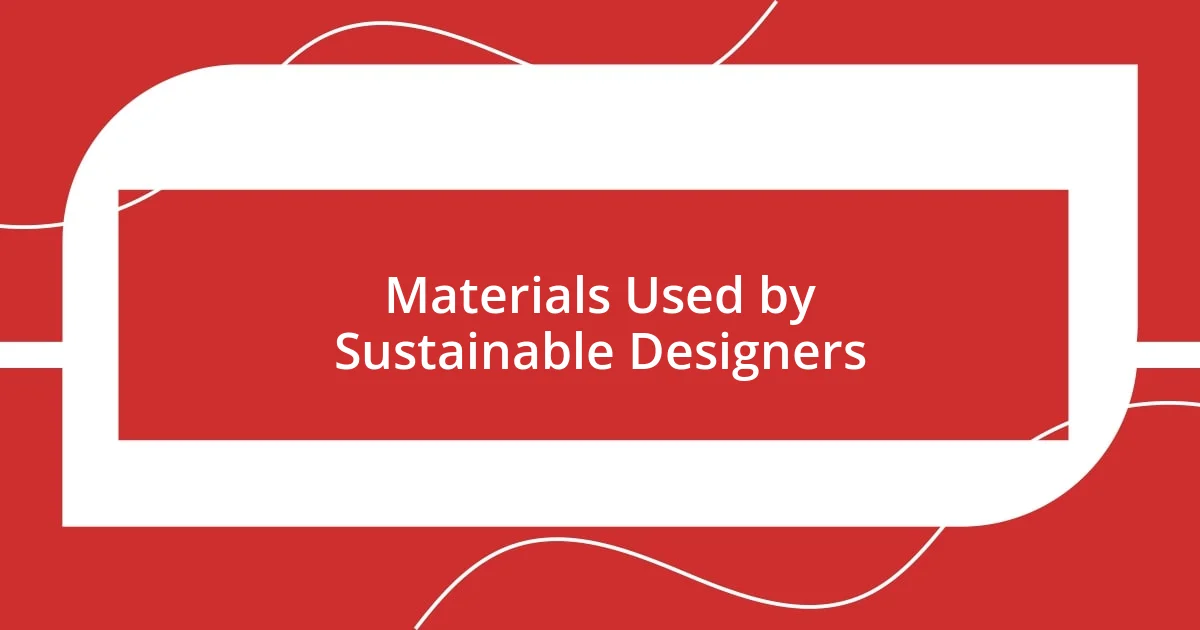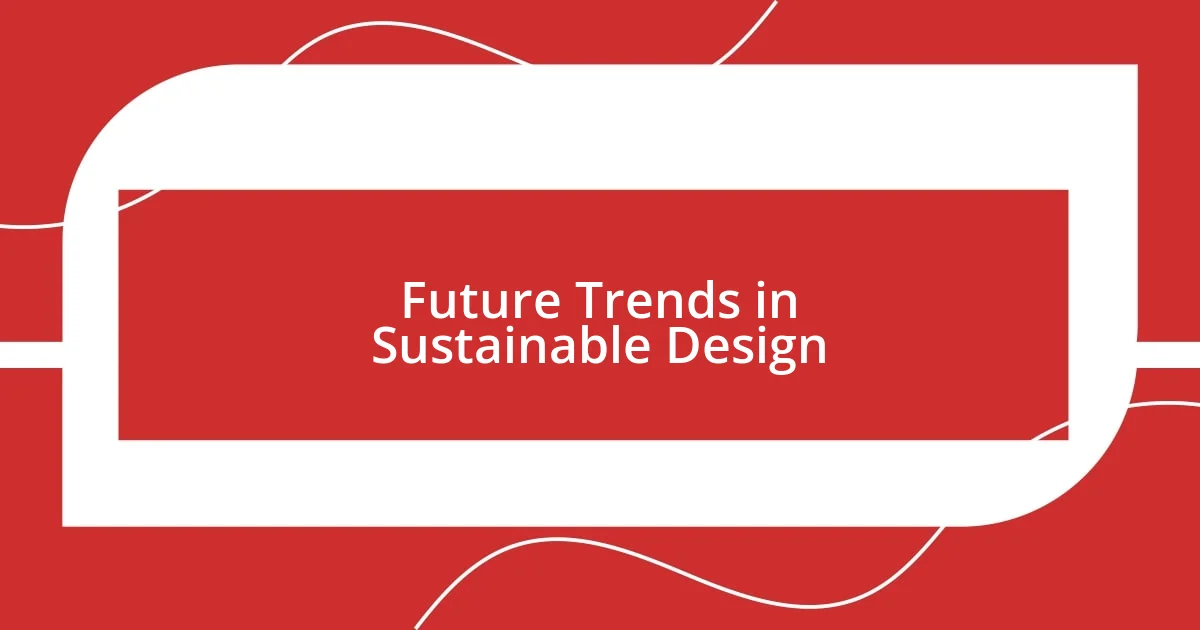Key takeaways:
- Sustainable design emphasizes a “cradle-to-cradle” approach, focusing on product lifecycle and environmental impact.
- Key characteristics of sustainable designers include innovative thinking, social responsibility, and collaboration with communities.
- Challenges in sustainability include sourcing eco-friendly materials at reasonable costs and changing consumer perceptions of sustainable products.

Understanding Sustainable Design Principles
Sustainable design principles are rooted in the idea of creating products and systems that not only serve their purpose but also respect and enhance the environment. I remember visiting a local design studio where the founder spoke passionately about using reclaimed materials. It really hit home for me when she described how each piece of wood had a story, transforming what could have been waste into usable art.
One key aspect of sustainable design is the concept of the “cradle-to-cradle” approach, which encourages designers to think about a product’s lifecycle. Have you ever thought about where your favorite product ends up after you’re done with it? Understanding this principle shifted my perception of everyday items from being disposable to becoming part of a larger ecosystem that can either harm or nurture our planet.
Another important principle is energy efficiency, which involves minimizing energy consumption during both production and usage. I once watched a documentary showcasing an eco-friendly building powered by solar panels, and the enthusiasm of its residents was palpable. It made me wonder—how much more connected we could feel to our surroundings if we prioritized designs that harmonize with nature instead of depleting it?

Key Characteristics of Sustainable Designers
Sustainable designers often prioritize innovation in materials and methods. I remember the excitement I felt when I discovered a designer who used biodegradable plastics made from natural resources like cornstarch. It was a fascinating moment for me, realizing that creativity could align so closely with responsibility. This commitment to forward-thinking solutions is a hallmark of the sustainable design movement.
Another defining characteristic is a strong commitment to social responsibility. I once attended a workshop focused on fair trade practices, where the speaker emphasized that sustainable design goes beyond environmental concerns; it also considers the well-being of communities involved in the supply chain. Have you ever wondered how your purchase choices can impact lives thousands of miles away? Learning about this connection made me feel more empowered to support brands that uplift rather than exploit.
Lastly, collaboration is at the heart of sustainable design. Once, I participated in a community project where designers, architects, and locals came together to reshape vacant lots into green parks. It was incredible to witness how diverse perspectives could coalesce into something beautiful. I believe this collective effort fosters a sense of ownership and connection among participants, further enhancing the impact of sustainable initiatives.
| Characteristic | Description |
|---|---|
| Innovative Thinking | Emphasis on creative solutions using eco-friendly materials. |
| Social Responsibility | Focus on ethical practices and community well-being. |
| Collaboration | Involvement of diverse stakeholders in the design process. |

Impact of Sustainable Practices
Sustainable practices have a significant impact not only on the environment but also on the communities involved in the design process. I recall volunteering for a project where we revamped a neighborhood’s playground using sustainably sourced materials. The sheer joy on the children’s faces as they played on equipment made from reclaimed wood was a powerful reminder of how design can transform lives. It’s amazing to see how sustainable practices can foster a deeper connection between people and their surroundings.
Here are some ways sustainable practices make an impact:
- Reduced Waste: Emphasizing the use of recycled materials significantly decreases landfill waste.
- Community Engagement: Involving local stakeholders often leads to designs that resonate with the community’s needs and values.
- Economic Benefits: Sustainable practices can stimulate local economies through job creation by investing in green technology.
- Health Improvements: Eco-friendly practices often enhance air and water quality, promoting overall community well-being.
- Enhanced Aesthetics: Thoughtful sustainable design can uplift environments, creating spaces that are not only functional but also beautiful.
When I think of the ripple effects of these practices, I can’t help but feel a sense of hope. They create a positive cycle where design becomes a catalyst for social and environmental good. Every step we take toward sustainability is a step toward a brighter future, and it’s exciting to imagine what lies ahead.

Materials Used by Sustainable Designers
Sustainable designers are constantly exploring innovative materials that are kinder to our planet. For instance, I recently encountered a stunning collection made from organic cotton and hemp, both of which are renewable resources. The texture and durability of these fabrics genuinely surprised me; they felt luxurious while embodying the ethos of sustainability. Have you ever run your fingers over a fabric and just felt the story it tells? That tactile experience can really transform how we view our everyday choices.
Beyond plant-based materials, the use of upcycled products is becoming increasingly popular. I remember visiting a workshop where artisans turned old denim into stylish bags and accessories. It struck me how these designers not only reduced waste but also celebrated the character and history of the fabric. It’s like giving a second life to something that could have ended up in a landfill. Don’t you think that each piece tells a story that connects us to both the past and future?
Moreover, I’m often impressed by how sustainable designers integrate alternative materials, like mycelium, which is derived from mushroom roots. I had the chance to see how a local start-up uses it to create faux leather products. The idea that something so natural can replace a material known for its environmental toll is inspiring. It makes me wonder: how far can our creativity take us in the name of sustainability? Each experiment with these unconventional materials feels like a step toward a future where design harmony exists with the environment.

Case Studies of Successful Designers
One designer that stands out to me is Stella McCartney, who has effectively redefined luxury fashion through sustainable practices. During a recent interview, she discussed her commitment to using cruelty-free and biodegradable materials, like recycled polyester derived from plastic bottles. It struck me how she combines high fashion with environmental responsibility—a challenging feat. Isn’t it fascinating to see a designer challenge the industry norms while continuing to create stunning pieces?
Another inspiring case is the work of Yves Béhar, whose company, fuseproject, designs impactful products with sustainability at their core. I remember reading about their design for the “One Laptop per Child” initiative. They managed to create affordable technology for children in underprivileged communities while focusing on minimum waste in production. The importance of merging social benefits with innovative design truly resonates with me. How often do we consider the lasting impact of our design choices on underserved populations?
Lastly, I was captivated by the approach of designer Mara Hoffman, who emphasizes transparency and ethical sourcing in her collections. At an event, she shared her journey of transitioning her brand to be more sustainable, which included a focus on natural dyes and materials. Hearing her passion made me reflect on how much responsibility we have as consumers. Are we aware of the stories behind the clothes we wear? It’s a vital conversation that we must embrace to drive change in the industry.

Challenges Facing Sustainable Designers
Sustainable designers often wrestle with the challenge of sourcing materials that are not only eco-friendly but also cost-effective. I once spoke with a designer who lamented the struggle of accessing sustainable fabrics at a reasonable price, especially when competing with mass-market products. Isn’t it disheartening that the mission to protect our planet can sometimes be overshadowed by the high costs associated with ethical sourcing?
Moreover, the perception of sustainability can be a double-edged sword. I remember attending a panel discussion where a designer expressed frustration over how some consumers equate eco-friendly products with a lack of style or quality. It’s ironic, isn’t it? Here they are, pouring their hearts into creating beautiful, sustainable pieces, only to face skepticism from those who have yet to embrace this new ethos. Shouldn’t luxury and sustainability walk hand in hand?
Finally, keeping consumers engaged in the lifelong journey of sustainable practices presents another hurdle. A friend of mine, a passionate advocate for sustainable fashion, once shared how easily people often slip back into old habits. She pointed out that while the appeal of sustainable design is undeniable, continuous education and dialogue about the benefits are crucial. Isn’t it interesting how awareness can often falter once the initial excitement fades? This ongoing conversation is something that sustainable designers must embrace to spark lasting change.

Future Trends in Sustainable Design
As I look ahead, one trend in sustainable design that excites me is the rise of circular economies. I recall a vibrant workshop I attended where experts discussed how companies can design products with their entire lifecycle in mind, ensuring they can be reused, repurposed, or recycled. Imagine living in a world where packaging becomes part of the product itself! It’s a fascinating shift that could redefine our relationship with consumption.
I’m also noticing a growing emphasis on local sourcing and production. A close friend of mine recently started a small clothing line focused on materials sourced within her community. She shared how this not only reduced carbon emissions from transportation but also created jobs locally. Isn’t it inspiring to think that sustainable design can bring communities together while minimizing environmental impact?
Lastly, the integration of technology in sustainable practices fascinates me. For instance, I recently came across a creative use of artificial intelligence to optimize resource use in fashion design. The potential for AI to assist designers in creating more efficient patterns and reducing waste makes me wonder: how can we leverage modern technology to enhance sustainability further? It’s a powerful question that many in the industry are beginning to explore.















